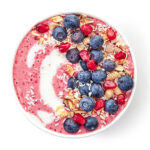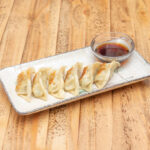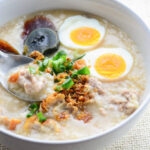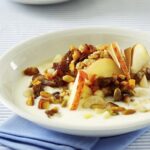Egg and vegetable congee is a comforting and nourishing dish originating from Asian cuisine, particularly China. It consists of rice cooked in water or broth until it breaks down into a thick, creamy porridge-like consistency. This versatile dish incorporates beaten eggs and various vegetables such as carrots, mushrooms, or spinach, adding both protein and nutrients. Seasonings like soy sauce, sesame oil, and garnishes such as green onions or cilantro further enhance its flavor. Egg and vegetable congee is often enjoyed as a hearty breakfast or as a comforting meal, especially during cold weather or when feeling unwell.
| Ingredients | |
| 1 | 1 cup long-grain white rice |
| 2 | 8 cups chicken or vegetable broth (or water) |
| 3 | 3 eggs, beaten |
| 4 | 1 cup mixed vegetables (carrots, mushrooms, spinach, etc.), diced |
| 5 | 2 tablespoons soy sauce |
| 6 | 1 tablespoon sesame oil |
| 7 | Salt and pepper to taste |
| 8 | Optional garnishes: chopped green onions, cilantro, fried shallots, roasted peanuts |
Step-by-step cooking instruction of Egg and Vegetable Congee:
Step-1 Rinse the rice: Rinse the rice under cold water until the water runs clear to remove excess starch.
Step-2 Cook the rice: In a large pot, bring the chicken or vegetable broth (or water) to a boil. Lower the heat to a low level and add the rinsed rice to the saucepan. Simmer the rice, stirring occasionally, for about 30-40 minutes or until the rice breaks down and becomes thick and creamy.
Step-3 Add the vegetables: Once the rice reaches a porridge-like consistency, add the diced mixed vegetables to the pot. Continue cooking for an additional 5-10 minutes until the vegetables are tender.
Step-4 Incorporate the eggs: Slowly pour the beaten eggs into the pot, stirring continuously to create ribbons of cooked egg throughout the congee. Cook for another 2-3 minutes until the eggs are fully cooked and incorporated into the mixture.
Step-5 Season the congee: Stir in the soy sauce and sesame oil to flavor the congee. If necessary, add more salt and pepper to taste and adjust the seasoning.
Step-6 Serve: Ladle the egg and vegetable congee into bowls. Garnish with chopped green onions, cilantro, fried shallots, or roasted peanuts if desired.
Step-7 Enjoy: Serve the congee hot and enjoy its comforting flavors and nourishing qualities.
Nutritional values of Egg and Vegetable Congee:
The nutritional value of egg and vegetable congee can vary depending on the specific ingredients used and the portion size. However, here’s a general overview of the nutritional benefits you can expect from this dish:
| 1 | Carbohydrates: Rice is the main ingredient in congee, providing carbohydrates, which are the body’s primary source of energy. |
| 2 | Protein: Eggs are a rich source of high-quality protein, providing essential amino acids necessary for muscle repair and growth. The addition of vegetables also contributes some protein to the dish. |
| 3 | Fiber: Vegetables added to the congee, such as carrots, mushrooms, and spinach, contribute dietary fiber, which supports digestive health and helps maintain a feeling of fullness. |
| 4 | Vitamins and Minerals: Vegetables in the congee provide essential vitamins and minerals such as vitamin A, vitamin C, vitamin K, folate, potassium, and magnesium, which are important for overall health and wellbeing. |
| 5 | Healthy Fats: Sesame oil used in seasoning the congee adds healthy fats, including monounsaturated and polyunsaturated fats, which are beneficial for heart health. |
| 6 | Low in Saturated Fat and Cholesterol: As long as you don’t add excessive amounts of oil or fatty ingredients, egg and vegetable congee tends to be low in saturated fat and cholesterol. |
| 7 | Calories: Depending on the portion size and specific ingredients used, egg and vegetable congee can vary in caloric content. It’s generally considered a relatively low-calorie dish, making it a suitable option for those looking to manage their weight. |
Background History of Egg and Vegetable Congee
Congee, also known as rice porridge or rice gruel, has a long history in Asian cuisine, particularly in China. It’s believed to have originated thousands of years ago, with references to rice porridge dating back to ancient Chinese texts.
Originally, congee was a simple dish made by boiling rice in water until it broke down into a thick, creamy consistency. It was a staple food for people across different social classes due to its affordability, ease of preparation, and versatility. Congee served as a comforting and nourishing meal, particularly during times of scarcity or when individuals were ill.
Over time, congee evolved, with various regional and cultural adaptations incorporating different ingredients and flavors. The addition of eggs, vegetables, meats, seafood, herbs, and spices transformed congee into a more diverse and flavorful dish.
Egg and vegetable congee, specifically, likely emerged as a variation that incorporated additional protein and nutrients from eggs and vegetables. This variation provided a more balanced and satisfying meal, appealing to a wider audience.
Today, egg and vegetable congee remains a popular dish in China and other Asian countries, enjoyed for its comforting qualities, versatility, and nutritional value. It’s often served for breakfast, as a comforting meal during cold weather, or as a remedy for those feeling unwell.
While the exact historical background of egg and vegetable congee may not be well-documented, its roots in Chinese culinary tradition and its evolution over time reflect the rich history and cultural significance of congee as a whole.
| Advantages of Egg and Vegetable Congee | |
| 1 | Nutritional Balance: Egg and vegetable congee provides a balanced combination of carbohydrates, protein, fiber, vitamins, and minerals from rice, eggs, and vegetables, offering a nutritious meal option. |
| 2 | High in Protein: Eggs are a rich source of high-quality protein, which is essential for muscle repair, growth, and overall health. |
| 3 | Versatility: Congee is highly versatile and can be customized with various vegetables and seasonings, allowing for flexibility in flavor and nutritional content. |
| 4 | Comforting and Nourishing: Egg and vegetable congee is a comforting and nourishing dish, often enjoyed during cold weather or when feeling unwell, providing warmth and sustenance. |
| 5 | Affordability: Rice, eggs, and vegetables are typically affordable and readily available ingredients, making egg and vegetable congee an economical meal option. |
| Ease of Digestion: Congee is easy to digest, making it suitable for individuals with digestive issues or those recovering from illness. |
| Disadvantages of Egg and Vegetable Congee | |
| 1 | Potential for High Sodium: Depending on the type and amount of broth or seasoning used, egg and vegetable congee may contain high levels of sodium, which can be detrimental to individuals with hypertension or other health conditions. |
| 2 | Caloric Content: While generally considered a healthy option, egg and vegetable congee can be calorie-dense, especially if large portions or excessive amounts of oil are consumed, which may not be appropriate for people who are watching their caloric intake. |
| 3 | Risk of Food Contamination: Improper storage or handling of leftover congee can increase the risk of bacterial contamination, leading to foodborne illnesses. |
| 4 | Limited Nutrient Diversity: While egg and vegetable congee provides a range of nutrients, it may lack the diversity of nutrients found in a more varied meal, especially if not supplemented with a wide variety of vegetables. |
| 5 | Potential for Allergies: Individuals with allergies to eggs or certain vegetables should exercise caution when consuming egg and vegetable congee, as it may contain allergenic ingredients. |
| 6 | Time-Consuming Preparation: While relatively simple to make, preparing egg and vegetable congee from scratch can be time-consuming, requiring several steps and a longer cooking time compared to other quick meal options. |
Compare with Similar meal of Egg and Vegetable Congee:
Several dishes share similarities with egg and vegetable congee, either in terms of ingredients or preparation method. Here are some similar meals:
| 1 | Rice Porridge with Toppings: Various cultures have their versions of rice porridge similar to congee. For example, in Korean cuisine, there’s “juk” or “jook,” which is a rice porridge often served with toppings like vegetables, meats, or seafood. |
| 2 | Arroz Caldor: This is a Filipino rice porridge similar to congee but typically made with chicken and flavored with garlic, ginger, and fish sauce. It’s often served with boiled eggs, green onions, and fried garlic as toppings. |
| 3 | Oatmeal with Eggs and Vegetables: While oatmeal is typically associated with sweet toppings, it can also be prepared savory by adding eggs and vegetables similar to egg and vegetable congee. |
| 4 | Millet Porridge: Millet porridge is a common dish in many parts of the world, particularly in Africa and Asia. Like congee, it can be made with a variety of ingredients, including eggs and vegetables, and served as a comforting meal. |
| 5 | Quinoa Porridge: Quinoa can be cooked similarly to rice to create a porridge-like consistency. It can be prepared with eggs and vegetables, providing a nutritious alternative to traditional rice-based congee. |
| 6 | Creamy Polenta with Eggs and Vegetables: Polenta, made from cornmeal, can be cooked into a creamy consistency similar to congee. It can be served with eggs and vegetables for a savory breakfast or brunch option. |
| 7 | Vegetable Soup with Rice or Pasta: While not a porridge, vegetable soup with rice or pasta shares some similarities with congee in terms of being a comforting and nourishing dish made with vegetables and grains. |
Mostly questions asked about Egg and Vegetable Congee
1: What is Egg and Vegetable Congee?
A: Egg and Vegetable Congee is a savory rice porridge dish originating from Asian cuisine, typically made with rice cooked in broth until creamy, and then mixed with beaten eggs and diced vegetables.
2: How do you make Egg and Vegetable Congee?
A: To make Egg and Vegetable Congee, cook rice in broth until creamy, then add beaten eggs and diced vegetables, and simmer until the eggs are cooked and vegetables are tender. Season to taste and serve hot.
3: What vegetables can I use in Egg and Vegetable Congee?
A: You can use a variety of vegetables in Egg and Vegetable Congee, such as carrots, mushrooms, spinach, bok choy, peas, corn, or any other vegetables you prefer.
4: Is Egg and Vegetable Congee healthy?
A: Yes, Egg and Vegetable Congee can be a healthy dish as it contains a balance of carbohydrates, protein, fiber, vitamins, and minerals from rice, eggs, and vegetables. However, it’s important to be mindful of portion sizes and added seasonings.
5: Can I make Egg and Vegetable Congee ahead of time?
A: Yes, Egg and Vegetable Congee can be made ahead of time and stored in the refrigerator for a few days. Before serving, just reheat it in the microwave or on the stove.
6: Is Egg and Vegetable Congee gluten-free?
A: Yes, Egg and Vegetable Congee is naturally gluten-free as it is made from rice, eggs, vegetables, and broth, which do not contain gluten. However, be sure to check the labels of any seasonings or sauces you add for gluten-containing ingredients.
7: Can I freeze Egg and Vegetable Congee?
A: Yes, Egg and Vegetable Congee can be frozen for longer storage. Allow it to cool completely, then transfer it to airtight containers or freezer bags and freeze for up to three months. Thaw in the refrigerator before reheating.
8: What can I serve with Egg and Vegetable Congee?
A: Egg and Vegetable Congee can be served on its own or with various toppings such as chopped green onions, cilantro, fried shallots, roasted peanuts, or a drizzle of soy sauce or sesame oil.
9: Can I make Egg and Vegetable Congee without eggs?
A: Yes, you can make Egg and Vegetable Congee without eggs if you have dietary restrictions or preferences. Simply omit the eggs and proceed with the recipe as usual.
10: Is Egg and Vegetable Congee suitable for vegetarians/vegans?
A: Yes, Egg and Vegetable Congee can be suitable for vegetarians if made with vegetable broth and omitting the eggs or using a vegan egg substitute. However, for vegans, it’s essential to ensure that all ingredients used are plant-based and free from animal products.







